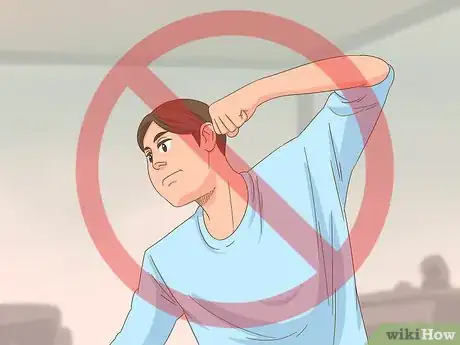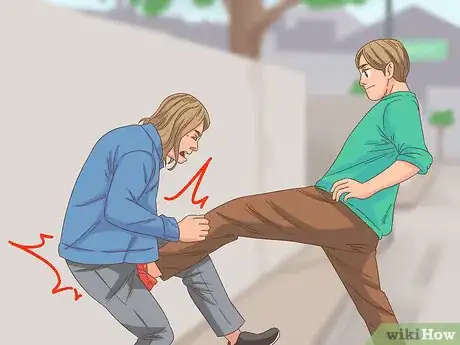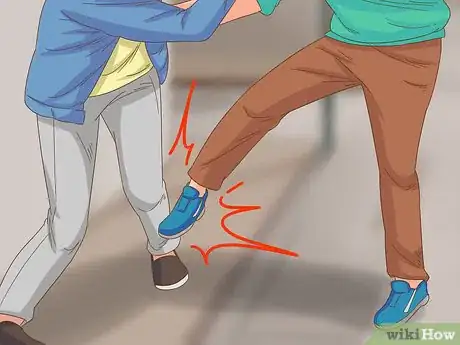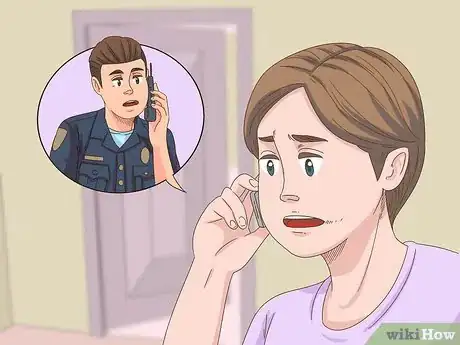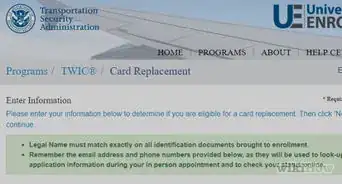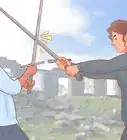This article was co-authored by Tsahi Shemesh. Tsahi Shemesh is a self-defense expert, specializing in Krav Maga. He began learnring Krav Maga in 1988, and trained directly under Imi Lichtenfeld, the founder of the sport. Shemesh is the Founder and Program Director of Krav Maga Experts in New York City. He has certified hundreds of instructors, trained a wide variety of professionals (including EMTs and NYPD officers), and his curriculum is taught in over a dozen countries worldwide.
There are 7 references cited in this article, which can be found at the bottom of the page.
wikiHow marks an article as reader-approved once it receives enough positive feedback. This article has 11 testimonials from our readers, earning it our reader-approved status.
This article has been viewed 403,517 times.
You may encounter many types of threat over the course of your life. Some threats are urgent, immediate, and violent. Other threats are non-immediate, but just as potentially harmful. Evaluate the decision and figure out what you need to do to keep yourself safe. Act quickly, calmly, and rationally.
Steps
Assessing the Situation
-
1Gauge the urgency of the threat. Decide how certain you are that the threatening person will follow through on his or her words. There is a wide margin between a threatening note and a man standing in front of you holding a knife. The way that you react will necessarily depend upon the immediate danger of the situation.
-
2Evaluate the situation. If the threat is immediate, then quickly and calmly look around you for potential defenses and escape routes. If the threat is more abstract, then try to get a clearer picture of what exactly is going on. Make sure that you understand why you're being threatened and what the actual risk is.[1]
- Why are you being threatened? If you don't know, ask. If you can't ask, then speculate.
- Do they want something from you? Consider giving a threatening person what he/she asks for. You never know how desperate someone is, and it is senseless to be killed over the contents of your wallet.
- Who is the leader of the group? If it comes down to you against them, then the leader may be your first target.
Advertisement -
3Assess the area. Are you familiar with the lay of the land? Are you under CCTV surveillance? Do you have a chance of escape? This will strongly define the actions that you take to deal with the situation.
Managing a Non-Immediate Threat
-
1Talk to the person. If you personally know the person who is threatening you, see if there's a way to resolve the situation without escalating it any further. Strike a deal, if you're being blackmailed or asked for something. Discuss the situation face-to-face and try to come to a mutual agreement.[2]
- Figure out whether you're being threatened for something valid. Perhaps the person thinks that you did something that you didn't do.
- Don't be too proud to apologize. A good apology can defuse some of the tensest situations.
-
2Deal with blackmail. Blackmail is still a threat, even if it is nonviolent. The way that you respond will depend upon what the person is holding over you and how much you have to lose. Make sure that you don't give in before you've considered other ways out. If you feel confident, take a stand.[3]
-
3Tell someone. Make sure that you aren't dealing with this alone. As soon as possible, involve someone that you trust: a teacher, a parent, a friend, a partner, a coworker, an authority figure. Together, you stand a better chance. Show the person any threatening messages, and make sure that he/she knows exactly who is threatening you.[4]
-
4Get a restraining order. If there is no other way to defuse the threat, then consider obtaining a court order for the person to stop bothering you. You'll need to prove the truth and urgency of the threat, and file a report with the local police department. You can ask for an order for the person to stop specific behaviors, or you can ask that the courts restrict the person from coming near you.
- Once you have a stay-away order against a person, he or she cannot come within a certain physical range of you – often on the order of 50-100 yards. This may not stop the threat if the person is desperate enough, but it will at least create a legal barrier.[5]
Handling an Immediate Threat
-
1Act nonviolently when possible. Try to handle the threat by giving in, or escaping, or talking your way out of the situation. You may find that people are much more reasonable than you expect.
- Decide whether you have an escape route. If they are only facing you, then you might run backwards. Run towards other people, there is safety in numbers.
- If there is no nonviolent way to escape, then you may need to defend yourself. Be prepared for this, but try not to make it your first reaction.
-
2Defend yourself. Be realistic about your chances. If you are outnumbered or otherwise outmatched, then it might be wise to first explore nonviolent solutions. Remember that violence is never a guaranteed method of dealing with someone. Once you escalate the situation, it may be very difficult to safely cool it back down.[6]
- If you are under CCTV surveillance and you plan to fight your way out of the situation, then you want the threatening person to make the first move. However, if you are outnumbered, and one or more of them is armed in some visible way, then this may be enough to justify your actions.
-
3Take down the leader. Try a kick to the groin, an elbow to the ribs, or a well-placed punch. No points for style or fair play – but if you put all your strength into it, he/she should hit the deck fast. Now you need to think again.
- Run now, if possible. Move quickly away through the space you just created. If you're lucky, the rest of the group will be momentarily distracted.
- If you can't get away, then you need to get something in between you and the rest of the group. One of the group will do nicely. Grab the closest one by the throat or neck—you want to be behind him so he is not in a good position—and make sure that you are hurting him enough that he won't attack you. Try grabbing his ear with your other arm and pulling it as hard as you can.
-
4Fight for it. Keep the fighting close and dirty. Dart in and out again, and don't let them grab you. You're finished once one or two of them catch hold of you. Run as soon as you get an opening.
- Kick the back of your "shield's" knees down to the floor in a very powerful stamp. Ideally you want to break something. You then need to deal with the others in a similar way.
- Try to go for unexpected targets. The knee is very weak, and can easily be broken with a kick.
- Sucker punches to the jaw can lay someone out, but they are so very expected that it's unlikely to come off.
-
5Contact the authorities. Tell the police or a security guard about the confrontation. Alternatively, use your cellphone or a payphone and call the emergency services. Do your best to accurately describe the situation: when, where, and what the threatening people looked like.[7]
Expert Q&A
-
QuestionHow do you deal with threats?
 Tsahi ShemeshTsahi Shemesh is a self-defense expert, specializing in Krav Maga. He began learnring Krav Maga in 1988, and trained directly under Imi Lichtenfeld, the founder of the sport. Shemesh is the Founder and Program Director of Krav Maga Experts in New York City. He has certified hundreds of instructors, trained a wide variety of professionals (including EMTs and NYPD officers), and his curriculum is taught in over a dozen countries worldwide.
Tsahi ShemeshTsahi Shemesh is a self-defense expert, specializing in Krav Maga. He began learnring Krav Maga in 1988, and trained directly under Imi Lichtenfeld, the founder of the sport. Shemesh is the Founder and Program Director of Krav Maga Experts in New York City. He has certified hundreds of instructors, trained a wide variety of professionals (including EMTs and NYPD officers), and his curriculum is taught in over a dozen countries worldwide.
Self Defense Trainer If you perceive a threat for a physical attack, follow these tips. Carry yourself with confidence to avoid a fight. The first step to de-escalating a fight is carrying yourself with confidence. Make yourself look strong physically and mentally so that you're not a target to predators. Predators are looking for someone who looks like an easy fight. Use your voice when you see an altercation coming. Have the confidence to use your voice the moment you recognize that the situation is escalating. Most people tend to obey their attacker, but a confident voice is one of the best tools you have. Give the person a chance to walk away before the fight even begins. Let the other person leave with their honor intact because once they feel they are losing your chances of de-escalating the fight decrease.
If you perceive a threat for a physical attack, follow these tips. Carry yourself with confidence to avoid a fight. The first step to de-escalating a fight is carrying yourself with confidence. Make yourself look strong physically and mentally so that you're not a target to predators. Predators are looking for someone who looks like an easy fight. Use your voice when you see an altercation coming. Have the confidence to use your voice the moment you recognize that the situation is escalating. Most people tend to obey their attacker, but a confident voice is one of the best tools you have. Give the person a chance to walk away before the fight even begins. Let the other person leave with their honor intact because once they feel they are losing your chances of de-escalating the fight decrease. -
QuestionHow do you respond to threats?
 Ross CascioRoss Cascio is a Krav Maga Worldwide self-defense, fitness, and fight instructor. He has been training and teaching Krav Maga self-defense, fitness, and fight classes at the Krav Maga Worldwide HQ Training Centers in Los Angeles, CA for over 15 years. He helps people become stronger, safer, and healthier through Krav Maga Worldwide training.
Ross CascioRoss Cascio is a Krav Maga Worldwide self-defense, fitness, and fight instructor. He has been training and teaching Krav Maga self-defense, fitness, and fight classes at the Krav Maga Worldwide HQ Training Centers in Los Angeles, CA for over 15 years. He helps people become stronger, safer, and healthier through Krav Maga Worldwide training.
Self Defense Trainer If all they want is possessions, give them what they want. If the attacker wants your wallet or your car, give it to them — possessions can be replaced. If, however, your attacker wants you to come with them or get into their vehicle, you need to stop them. Use an assertive voice to tell them to stop or back up. A confident voice can get the attention of others and can thwart an attack.
If all they want is possessions, give them what they want. If the attacker wants your wallet or your car, give it to them — possessions can be replaced. If, however, your attacker wants you to come with them or get into their vehicle, you need to stop them. Use an assertive voice to tell them to stop or back up. A confident voice can get the attention of others and can thwart an attack.
Warnings
- If you know the attack is coming, avoid the people/place/things that will spark the confrontation.⧼thumbs_response⧽
- If you are involved in any "underground" activities (drugs, "birds of the night", gangs) make sure you're always in good company. Don't get in over your head.⧼thumbs_response⧽
- Always try to get away from the situation before resorting to violence.⧼thumbs_response⧽
- Carry a cellphone with you at all times. You might not be able to use it in front of your attackers, but it will come in handy later on. Call the emergency services immediately using your cell phone if they've managed to injure you in any way. That cut you got from the guy in the dew-rag might end up giving you a disease.⧼thumbs_response⧽
References
- ↑ http://www.justice-integrity.org/faq/262-how-to-deal-with-a-death-threat
- ↑ http://jezebel.com/the-cops-dont-care-about-violent-online-threats-what-d-1682577343
- ↑ http://www.askmen.com/money/mafioso_100/116_mafia.html
- ↑ http://www.schoolsecurity.org/trends/threat-assessment-threats-rumors-text-messages/
- ↑ http://www.courts.ca.gov/1260.htm
- ↑ http://www.slate.com/blogs/quora/2013/11/25/police_and_threats_how_does_law_enforcement_handle_retaliation_threats.html
- ↑ http://www.justice.gov.yk.ca/prog/cor/vs/physical_violence.html
About This Article
To deal with a threat, start by gauging the urgency of the threat. If the threat is more abstract and less immediate, like blackmail, try to get a clear picture of why you're being threatened. If you know the person who is threatening you, ask if you can resolve the situation in some way without escalating it any further. For more immediate threats, check around you for potential defense mechanisms and escape routes. If you have no choice but to physically engage, kick the person in the groin, elbow them in the ribs, or punch them. You can use the moments immediately after that to make your escape. Be sure to contact the authorities as soon as possible to describe your attacker and the location of the incident. For more tips on handling yourself in a physical altercation, read on!







